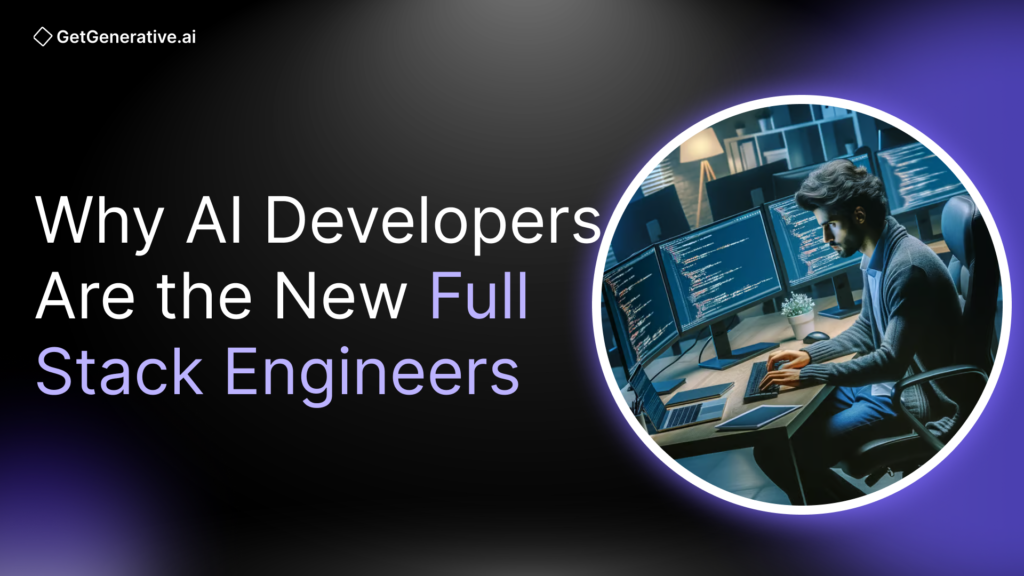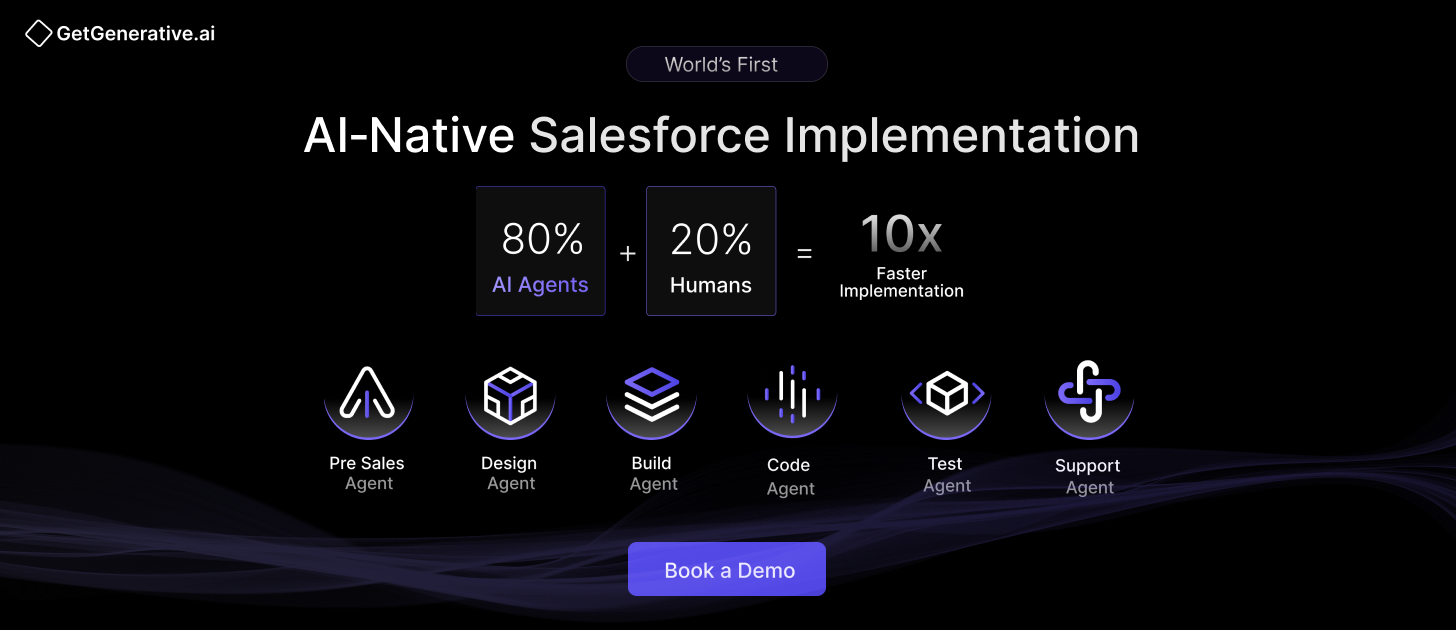Why AI Developers Are the New Full Stack Engineers
In 2025, the demand for AI expertise is skyrocketing. U.S. job postings for AI-related roles surged by 25% year-over-year, and the median salary for AI positions hit $157,000.
But the flip side of this boom is a severe talent shortage: over 4.2 million unfilled AI developer positions exist worldwide, costing companies an average of $2.8 million annually in delays and lost productivity.
This rapid shift is collapsing traditional software development silos. Today’s AI engineers are no longer confined to algorithm design or data science—they are writing code, building user interfaces, managing cloud deployments, and fine-tuning models. As a result, the line between “AI developer” and “full-stack engineer” is fading. A new archetype is emerging: the full-stack AI developer.
This blog explores how and why AI developers have taken on full-stack responsibilities, supported by real data, market trends, and actionable strategies for organizations preparing for this evolution. Let’s get started!
The Evolution of Full-Stack Development
The concept of a “full-stack developer” has transformed over the past two decades. In the early 2010s, it referred to engineers who could handle both front-end technologies (HTML/CSS/JavaScript) and back-end systems (Python, PHP, Ruby). By the mid-2010s, as cloud platforms matured, full-stack engineers were also expected to handle AWS, containers, CI/CD pipelines, and DevOps.
Fast forward to 2025: full-stack developers now need to understand machine learning, LLMs, and AI APIs.
As GitHub CTO Inbal Shani recently noted, developers are expected to “understand how LLMs work, prompt them effectively, fine-tune them, and integrate them into apps.”
The role now includes building intelligent, adaptive systems—not just user interfaces or databases.
The result is a hybrid professional who builds entire AI-augmented systems. These modern full-stack engineers must decide when to hand over logic to an AI model versus relying on hard-coded rules—decisions that weren’t even on the radar a decade ago.
The Rise of AI Developers as Full-Stack Generalists
AI developers today are no longer niche specialists who hand off their models to software engineers for integration. They are the integration point.
A full-stack AI developer is someone who can:
- Build scalable web applications
- Architect cloud infrastructure
- Train and fine-tune ML/NLP models
- Design APIs and UIs
- Monitor deployed AI systems in production
They are not “just” data scientists. They are versatile engineers capable of end-to-end ownership, from preprocessing data and model selection to delivering user-facing AI features.
A 2025 Veritone labor report highlighted this shift, noting a 41.8% YoY increase in AI/Machine Learning Engineer job titles and over 35,000 new AI job postings in Q1 2025 in the U.S. alone. The demand isn’t just coming from tech giants—industries from healthcare and fintech to retail and logistics are racing to embed AI in their workflows.
Related Read – Is AI Replacing Developers? Not Exactly—Here’s What’s Really Happening
Skills That Define the Full-Stack AI Developer
Here’s what the “full stack” now looks like for AI developers in 2025:
Front-End Development
- Tools: React, Vue.js, Angular
- Purpose: Build chatbots, interactive dashboards, LLM-based forms
- Example: Designing a UI for an AI-powered support assistant using React + OpenAI API.
Back-End Engineering
- Languages: Python, Node.js, Go
- Workflows: Develop REST APIs, manage async inference calls
- Example: Hosting a sentiment analysis model through FastAPI with Redis queueing.
Machine Learning & Deep Learning
- Frameworks: PyTorch, TensorFlow, Hugging Face
- Tasks: Model training, fine-tuning, transfer learning
- Example: Fine-tuning a BERT model on domain-specific data.
DevOps & MLOps
- Tools: Docker, Kubernetes, MLflow, SageMaker
- Tasks: Model deployment, version control, monitoring, CI/CD
- Example: Setting up automatic retraining pipelines triggered by data drift alerts.
Data Engineering
- Tools: Apache Spark, Airflow, Delta Lake
- Workflows: Preprocess raw data, feature engineering, orchestrate pipelines
- Example: Cleaning and batching financial transactions for fraud-detection training sets.
Soft Skills & Cross-Functional Collaboration
- Roles: Align with product, UX, business goals
- Tasks: Translate ML insights to stakeholders
- Example: Explaining LLM-based content personalization logic to a marketing team.
This broad expertise is no longer optional—it’s expected. A 2025 industry report states that 87% of companies struggle to hire AI developers, citing that they must “combine deep domain knowledge, coding proficiency, and data literacy.”
Market Trends Driving the Shift
1. Talent Gap and Salary Inflation
- Estimated 4.2 million unfilled AI jobs globally (source: Fullscale.io)
- Only ~320,000 qualified candidates available
- Average time-to-fill: 142 days
- Salaries rising at 32% YoY, with median U.S. AI dev salaries now $157K
2. AI as a Core Business Strategy
According to Gartner, by the end of 2025:
- 95% of new software products will include AI features.
- 75% of business leaders plan to operationalize AI within core functions.
As AI becomes part of every product roadmap, developers who understand AI across the stack are not just helpful—they’re critical.
3. Tooling Amplifies Talent
Tools like:
- GitHub Copilot (code autocomplete)
- Google AutoML (low-code training)
- OpenAI Codex (function generation)
These don’t replace engineers. They amplify productivity—tripling throughput in some orgs—while also demanding that developers understand AI’s limitations, ethics, and guardrails.
The Role of MLOps in Full-Stack AI Engineering
As AI matures from experimental projects to production-critical infrastructure, the emphasis shifts from model accuracy to model reliability, scalability, and maintainability. Enter MLOps—the machine learning counterpart to DevOps.
What Is MLOps?
MLOps encompasses the tools, processes, and best practices needed to:
- Version datasets and models
- Automate training and deployment pipelines
- Monitor production performance (accuracy, latency, bias)
- Retrain models in response to concept drift or new data
A market report by Fortune Business Insights projects that the global MLOps market will grow from $4.5 billion in 2024 to over $20 billion by 2034, underscoring its rising importance in enterprise workflows.
Why It Matters
AI developers must now manage not just codebases, but also data and model lifecycles. This means handling:
- Continuous Integration/Continuous Deployment (CI/CD) for ML
- Infrastructure provisioning (e.g., provisioning GPU nodes via Terraform)
- Containerization of models using Docker and Kubernetes
- Creating reproducible training environments and pipelines
For example, in a fraud detection system, an AI developer might:
- Set up a pipeline that automatically re-trains the model weekly
- Validate new model versions using shadow deployment
- Monitor inference latency and accuracy via Prometheus and Grafana
Such workflows go far beyond traditional full-stack responsibilities, but they are now central to full-stack AI development.
Also Read – A Comprehensive Guide to Vibe Coding Tools
Strategic Recommendations for Organizations
Given the strategic importance of AI developers with full-stack capabilities, how should companies respond?
1. Invest in Upskilling Your Current Workforce
Many AI skills—especially in applied ML and MLOps—can be taught.
- Encourage backend/frontend developers to take courses in ML (e.g., DeepLearning.AI, Fast.ai)
- Provide sandbox environments for experimentation
- Host internal AI hackathons to surface talent
2. Hire for Hybrid Skill Sets
Look for engineers who combine:
- Software development skills (e.g., API design, frontend/backend frameworks)
- Data literacy (e.g., pandas, SQL, data cleaning)
- ML tool familiarity (e.g., PyTorch, Scikit-learn, Hugging Face Transformers)
Search for job titles like:
- Full-Stack AI Developer
- Machine Learning Engineer
- AI Solutions Architect
Consider updating job descriptions to explicitly mention MLOps tools, cloud deployment skills, and familiarity with AI frameworks.
3. Adopt a Product-Centric, Cross-Functional Team Structure
Break down organizational silos between:
- Data scientists
- Frontend/backend engineers
- Infrastructure/DevOps teams
Instead, structure teams around end-to-end product features—each team owning the design, build, training, deployment, and monitoring of intelligent features. This mirrors Agile product squads but is tailored for AI-driven products.
4. Use AI-Native Tools to Accelerate Development
Boost productivity using AI-native development tools like:
- GitHub Copilot – auto-suggest boilerplate code
- Codeium, Tabnine – for AI code completion
- Hugging Face AutoTrain – for low-code model training
- Google Vertex AI or AWS SageMaker – for full MLOps pipelines
5. Measure What Matters
Set KPIs for your AI engineering teams that span both:
- Technical metrics (e.g., model accuracy, latency, uptime, retraining frequency)
- Business outcomes (e.g., feature adoption, churn reduction, upsell conversion rates)
Tie performance reviews and bonuses to cross-functional outcomes rather than siloed metrics. This reinforces the full-stack AI mindset.
Conclusion
In 2025, AI developers are not niche technologists—they are the new full-stack engineers. They span the entire lifecycle of modern applications: from data pipelines and model training to cloud deployment and user interfaces. This hybrid role is driven by necessity, shaped by tooling, and defined by cross-disciplinary excellence.
Salesforce in Days, Not Months
At GetGenerative.ai, we’ve reimagined Salesforce implementation—built from the ground up with AI at the core. This isn’t legacy delivery with AI added on. It’s a faster, smarter, AI-native approach powered by our proprietary platform.
👉 Explore our Salesforce AI consulting services




